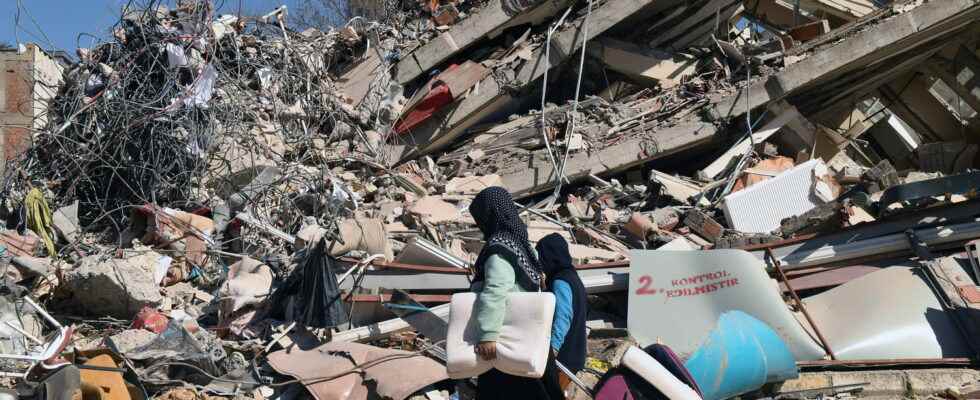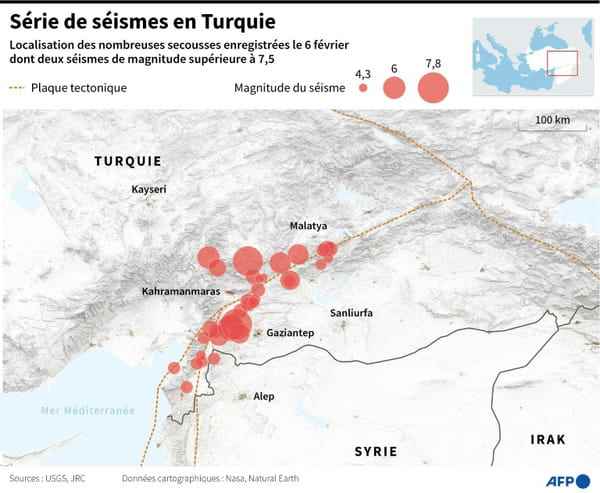TURKEY EARTHQUAKE. In Turkey, violent earthquakes caused the death of tens of thousands of people in the south of the country. But what would such a balance sheet have represented if these earthquakes had taken place in France?
40,689. This is therefore the almost final assessment of the terrible earthquake which struck Turkey on February 6, 2023. Two weeks after an earthquake which also caused damage in Syria (more than 4,000 dead), research were stopped in the country. The hope of finding new survivors is slim, even if miracles have occurred: three people in particular were discovered alive on February 18, under the rubble. However, this earthquake was the fifth deadliest since the beginning of the 21st century, after that in Haiti in 2010 (316,000 dead), in Sumatra in Indonesia in 2004 (227,899), in the Prince of Sichuan in China in 2008 ( 87,652), and that in Pakistan in 2005 (76,213).
What do 41,000 dead represent on the scale of a French city?
Impressive figures but sometimes difficult to represent concretely. So, what would such a balance sheet represent in France? In France, only 183 cities would still have inhabitants if so many deaths had been recorded on their territory.
With our search engine, find out what share of the population of your municipality or department represents this human toll. To do this, simply enter the name of your municipality or department in place of Paris and press “Search”. Attention, it is however necessary to write the exact name of the municipality with the first letter in capitals, the accents and dashes.
How to read the gauge?
Once the name of the municipality or the department has been written, and after having clicked on “Search”, a percentage will appear, under the gauge. This represents the share of the population that would have died if 41,000 people had died in the chosen city or department. The majority of municipalities therefore exceed 100%. To better understand, 200% is equivalent to double the current population, 1000% to 10 times the population, 10000% 100 times etc…
An earthquake on an area equivalent to PACA and Auvergne-Rhône-Alpes
Beyond a very heavy human toll, it is a whole part of Turkey – but also of Syria – which felt the tremors, first in the middle of the night, then during the aftershocks during the day. 10 Turkish provinces were affected by the earthquakes, all in the south of the country: Kahramanmaras, Adıyaman, Kilis, Osmaniye, Gaziantep, Malatya, Şanlıurfa, Diyarbakır, Adana and Hatay. In total, 100,576 km² of Turkey were affected by the earthquake. On a European scale, this represents more than Hungary alone.
And on the scale of France? If such an earthquake had struck France, several regions would have been affected. By transposing the area of the Turkish seismic event to the French regions, this corresponds either to Provence-Alpes-Côte-d’Azur and Auvergne-Rhône-Alpes which, combined areas, make 101,111 km² (in dark red on the map); that is, almost, to the sum of the Brittany, Pays de la Loire and Centre-Val-de-Loire regions, which together represent 98,441 km² (in light red). Excluding Corsica from the calculation, the earthquake would therefore have affected 1/5th of metropolitan France.
In Turkey, 1% of the population of the affected regions impacted
This exceptionally large natural disaster marked Turkey by the heavy human toll it caused. On the scale of the ten regions concerned, the nearly 40,700 people killed by the earthquake represent 0.34% of the total population of these provinces. According to the 2013 census, nearly 12 million people live in the different cities of these regions. Taking into account the more than 100,000 injured, this makes 1.25% of the population affected by the tremors. But that’s not counting the impact on the lives of tens of thousands of other Turks, while more than 100,000 buildings were damaged.
Turkey earthquake: what happened
Monday February 6, 2023, at 4:17 and 36 seconds in Turkey (2:17 in France), a first earthquake occurred in the south of the country, near Gaziantep and Kahramanmaraş, in the south of the country. The tremors lasted two minutes with power reaching 7.8 on the Richter scale. At 1:24 p.m. and 49 seconds (11:24 a.m. in France), a second earthquake of magnitude 7.5 was felt nearly 100 km northwest of the first, near Ekinözü. Throughout the day, more than 120 aftershocks, of different magnitudes, were measured by the authorities. While the earth shook mainly in Turkey, northern Syria, a border country, was also affected. On February 20, a new earthquake was recorded at 8:04 p.m. (6:04 p.m. in France) in the province of Hatay, already heavily affected by the first tremors. 90 aftershocks followed.
The rumblings of the Earth have done immense damage in Turkey but also in Syria. According to the latest official report issued on Sunday February 19, more than 45,000 people died as a result of the earthquakes, including 40,689 in Turkey and approximately 5,000 in Syria. The aftershocks recorded on February 20 led to the death of six new people in Turkey, causing another 300 injuries. The first earthquakes had injured more than 100,000 people.
Turkish authorities also said that 105,000 buildings had collapsed following the February 6 earthquakes and that 2.2 million people had fled the affected areas. In addition to the physical victims of the earthquakes, the World Health Organization (WHO) estimates that 26 million people are at risk of being “potentially exposed” to the consequences of the earthquake in Turkey, “including around five million vulnerable people”. The same organization also fears that a major health crisis will occur after the natural disaster.
The first earthquake in Turkey, that of magnitude 7.8, occurred in the district of Pazarcik, in the south-east of Turkey, located about sixty kilometers with the Syrian border and 17.9 kilometers deep according to the the American Institute of Geophysics (USGS). However, the force of the earthquake was felt even in neighboring countries such as Jordan, Lebanon and Cyprus.
A few hours later, the second earthquake started about a hundred kilometers from the epicenter of the first. With a magnitude of 7.5, the earthquake shook a large part of Anatolia: from Ankara and Diyarbakır, cities 670 kilometers apart from east to west, and from Malatya to Adana separated by 300 kilometers from north to south .

